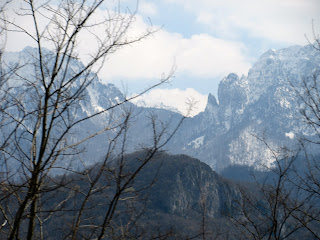With the sentencing
last Thursday of
Radovan Karadzic for his atrocities against the citizens of Bosnia and Herzegovina during the war from 1992-95... it added to the emotions of our trip to Sarajevo and Mostar.
To try and wrap your arms around, what is Bosnia, is no easy task. There are two geographic regions, Bosnia in the north and Herzegovina in the south. As you cross the border you see signs, welcome to the Republic of Srpska which is an administrative entity after the dissolution of Yugoslavia. Srpska is predominantly Serbian. Today the system of government is such that the Presidency is comprised of 3 members -a Bosniak, a Croat, and a Serb, with the chair rotating every 8 months.
For the 500 years of Ottoman rule, Sarajevo was the biggest Turkish community outside Istanbul. History runs deep and you still feel that Turkish influence. About one in 10 women currently wear headscarves.
 |
| Remnants of the old walls of the city |
 |
| Renovated hamam baths |
 |
| Above, the national museum depicts Ottoman homes and below a restaurant we ate in |
 |
| Turkish coffee as the main staple |
In 1914, a Bosnian radical killed the Archduke Frans Ferdinand (Austrian Hungarian Empire) on one of the bridges in town. He then killed the Duke's pregnant wife. Thus, they say, started WWI.
After WWII, Bosnia became part of Yugoslavia. For years, three groups of people from three different religions lived peacefully together: the Croatians who were Catholic, the Bosniaks who were Muslim and the Serbians who were Orthodox.
With the break up of Yugoslavia in the early 1990s, tensions mounted. In 1991 Karadzic, the man recently sentenced to 40 years in prison is quoted as saying to the Bosniaks that if they try to pull out of Yugoslavia, "They will disappear. Sarajevo will be a black cauldron where 300,000 Muslims will die. It will be a real bloodbath". Many would call him a man of his word!
 |
| These 3 photos show the terrain of Sarajevo, set in a river valley which made it easy for the Serbian snipers to fire down on the people of the city, regardless of their religion |
 |
| For 1425 days, over 4 years, the people of Sarajevo lived in a war zone. This is the longest siege of a city since WWII. With 350,000 people entrapped in the city, 4% of the population was killed and 70,000 adults and children were injured. On July 22, 1993, 3,777 shells were fired down on the city! |
|
 |
| Above is one of the many graveyards decorating the hillsides of those killed during the war. Below was a common sight. These are the names of those killed in or near this building. |
 |
| This is the new elaborate library. Many would gather in the old building during the war to have some peace and enjoy their precious books. When it was completely destroyed, it represented a major "hit" to their psyche. |
 |
| This was an advertisment for an exhibit on the massacre in Srebrenica. This Bosnian town was the sight of a July 1995 massacre of the town's Bosniak population, determined to have been a crime of genocide. More than 8,000 men and boys were killed. |
Traveling 2 hours toward the coast, now in the territory of Herzegovina, is the river town of Mostar
 |
| The famous bridge that was covered with pieces of wood (see below) during the heavy fighting here to somewhat protect those crossing the bridge. When the bridge was finally destroyed, it cut off the flow between the two sides of the city. |
 |
| This was a graphic on the side of a building, commemorating the reconstruction of the bridge in 2004. |
 |
| Modern Mostar with it's vibrant Turkish bazaar below |
 |
| For a few coins, you can watch someone jump to the water below |
Today, Sarajevo is a bustling city
The people pride themselves on their food and raki made from many fruits and nuts.
 |
| Modern market with their famous smoked meats being examined by a customer below! |
 |
| Turkish candies |
 |
| The national beer was in evidence |
 |
| At one restaurant there were two pages of various Rakis one could sample |
 |
| This is the traditional simple dish: minced meat, pita bread, raw onions and some fries called "cevapi". |
 |
| There were many open air markets selling mostly organic products. In the background, wonderful parks |
 |
| Faces of a few of the market sellers |
 |
| Pass time pleasure for the men |
 |
| Time to pray at the mosque |
|
 |
| These three photos are simply designs I spotted in the colorful city |
 |
The scenery driving to Bosnia from Tirana is not shabby as you will see below!
|
On the way back to Albania, Peter spots a Raki still in someone's modest yard. We drop by to sample.
We leave Bosnia, Herzegovina and Srpska and pause to consider those who have died in this horrific war only 21 years ago.
May the next generation of those living in this country grow up in peace!



























































